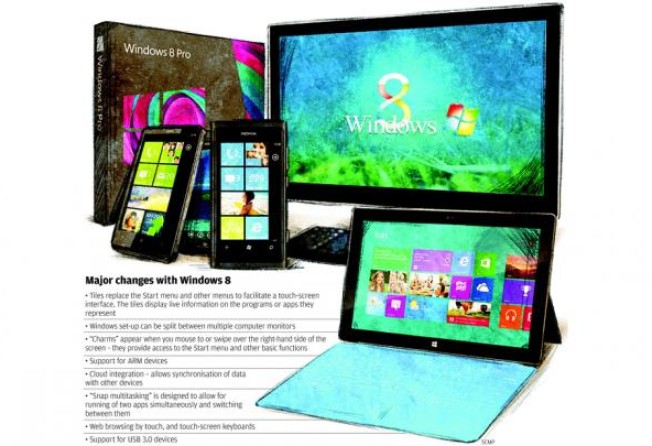
Windows pain in Microsoft shake-up
The world's most familiar computer system is getting a radical makeover that is likely to baffle many after it goes on sale on Friday

Over the years, Keith McCarthy has become used to a certain way of doing things on his personal computers, which, like most others, have long run on Microsoft's Windows software.
But last week, when he got his hands on a laptop running the newest version of Windows for the first time, McCarthy was flummoxed. Many of the familiar signposts from PCs of yore are gone in the new software, Windows 8, like the Start button for getting to programs and the drop-down menus that list their functions. It took McCarthy several minutes just to figure out how to compose an email message in Windows 8, which has a stripped-down look and on-screen buttons that at times resemble the runic assembly instructions for Ikea furniture.
"It made me feel like the biggest amateur computer user ever," said McCarthy, 59, a copywriter in New York.
Windows, which has more than 1 billion users around the world, is getting a radical makeover, a rare move for a product with such vast reach. The new design is likely to cause some head-scratching for those who buy the latest machines when Windows 8 goes on sale on Friday.
To Microsoft and early fans of Windows 8, the software is a bold reinvention of the operating system for an era of touch-screen devices like the iPad, which are reshaping computing. Microsoft needs the software to succeed so it can restore some of its fading relevance after years of watching the likes of Apple and Google outflank it in the mobile market.
To its detractors, though, Windows 8 is a renovation gone wrong, one that will needlessly force people to relearn how they use a device every bit as common as a microwave oven.
"I don't think any user was asking for that," said John Ludwig, a former Microsoft executive who worked on Windows and is now a venture capitalist. "They just want the current user interface, but better."
Ludwig said Microsoft's strategy was risky, but it had to do something to improve its chances in the mobile business: "Doing nothing was a strategy that was sure to fail."
Little about the new Windows will look familiar to those who have used older versions. The Start screen, a kind of main menu, is dominated by a colourful grid of rectangles and squares that users can tap or click with a mouse to start applications. Many of these live tiles constantly flicker with new information piped in from the Internet, like news headlines, email subject lines and Facebook photos.
What is harder to find are many of the conventions that have been a part of PCs since most people began using them, like the strip of icons at the bottom of the screen for jumping between applications. There is a more conventional "desktop" mode for running Microsoft Office and older programs, though there is no way to permanently switch to it.
Microsoft knew in 2009 that it wanted to shake up Windows. It held focus groups and showed people prototypes of the tile interface and its live updates.
"We would get this delightful reaction of people who would say, 'This is so great, and it has Office too,"' said Jensen Harris, Microsoft's director of program management for the Windows user experience.
As work on Windows 8 proceeded, the company let the wider public test it. Sixteen million people have been using early versions, providing feedback either automatically or in forums.
The boldness of the changes has delighted some early users, who say they believe that for the first time, the company is taking greater creative risks than its more celebrated rival, Apple.
To help it gain traction in the mobile market, Microsoft made Windows 8 a one-size-fits-all operating system for touch-screen tablets, conventional computers with keyboards and mice, and newer devices that combine elements of both. The company's latest software for phones has the same tile-based aesthetic.